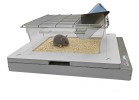Authors
H Djemai, M Hassani, N Daou, Z Li, A Sotiropoulos et al
Lab
UniversitŽ Paris Descartes, Sorbonne Paris CitŽ, Paris, France
Journal
European Journal of
Abstract
Physical exercise has important effects as secondary prevention or intervention against several diseases. Endurance exercise induces local and global effects, resulting in skeletal muscle adaptations to aerobic activity and contributes to an amelioration of muscle performance. Furthermore, it prevents muscle loss. Serum response factor (Srf) is a transcription factor of pivotal importance for muscle tissues and animal models of Srf genetic deletion/over-expression are widely used to study Srf role in muscle homeostasis, physiology and pathology. A global characterisation of exercise adaptation in the absence of Srf has not been reported. We measured body composition, muscle force, running speed, energy expenditure and metabolism in WT and inducible skeletal muscle-specific Srf KO mice, following three weeks of voluntary exercise by wheel running. We found a major improvement in the aerobic capacity and muscle function in WT mice following exercise, as expected, and no major differences were observed in Srf KO mice as compared to WT mice, following exercise. Taken together, these observations suggest that Srf is not required for an early (within 3 weeks) adaptation to spontaneous exercise and that Srf KO mice behave similarly to the WT in terms of spontaneous physical activity and the resulting adaptive responses. Therefore, Srf KO mice can be used in functional muscle studies, without the results being affected by the lack of Srf. Since lack of Srf induces premature sarcopenia, our observations suggest that the modifications due to the absence of Srf take time to occur and that young, Srf KO mice behave similarly to WT in aerobic physical activities.
BIOSEB Instruments Used:
Activmeter (BIO-ACTIV-R)

 Pain - Thermal Allodynia / Hyperalgesia
Pain - Thermal Allodynia / Hyperalgesia Pain - Spontaneous Pain - Postural Deficit
Pain - Spontaneous Pain - Postural Deficit Pain - Mechanical Allodynia / Hyperalgesia
Pain - Mechanical Allodynia / Hyperalgesia Learning/Memory - Attention - Addiction
Learning/Memory - Attention - Addiction Physiology & Respiratory Research
Physiology & Respiratory Research
 Pain
Pain Central Nervous System (CNS)
Central Nervous System (CNS) Neurodegeneration
Neurodegeneration Sensory system
Sensory system Motor control
Motor control Mood Disorders
Mood Disorders Other disorders
Other disorders Muscular system
Muscular system Joints
Joints Metabolism
Metabolism Cross-disciplinary subjects
Cross-disciplinary subjects Preclinical studies and opioids: role in crisis management in the United States
Preclinical studies and opioids: role in crisis management in the United States 